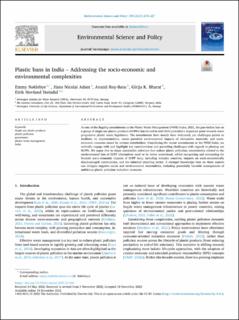| dc.contributor.author | Nøklebye, Emmy | |
| dc.contributor.author | Adam, Hans Nicolai | |
| dc.contributor.author | Roy-Basu, Avanti | |
| dc.contributor.author | Bharat, Girija K. | |
| dc.contributor.author | Steindal, Eirik Hovland | |
| dc.date.accessioned | 2023-03-23T13:51:00Z | |
| dc.date.available | 2023-03-23T13:51:00Z | |
| dc.date.created | 2023-03-08T13:41:38Z | |
| dc.date.issued | 2023 | |
| dc.identifier.citation | Environmental Science and Policy. 2023, 139, 219-227. | en_US |
| dc.identifier.issn | 1462-9011 | |
| dc.identifier.uri | https://hdl.handle.net/11250/3060188 | |
| dc.description.abstract | As one of the flagship amendments to the Plastic Waste Management (PWM) Rules, 2021, the pan-Indian ban on a group of single-use plastic products (SUPPs) introduced in mid-2022 provided a departure point towards more progressive plastic waste legislation. The amendments have mostly been welcomed, yet challenges persist to facilitate its implementation, assess potential environmental impacts of alternative materials, and socio-economic concerns raised by various stakeholders. Considering the recent amendments to the PWM Rules, we critically engage with and highlight key considerations and prevailing challenges with regards to phasing out SUPPs. We argue that to shape sustainable solutions that reduce plastic pollution, uncertainties related to the environmental fate of SUPP alternatives need to be better understood, whilst recognising and accounting for broader socio-economic impacts of SUPP bans, including industry concerns, impacts on socio-economically disadvantaged communities, and the informal recycling sector. A stronger knowledge base on these aspects can mitigate negative social and environmental externalities, including potentially harmful consequences of ambitious plastic pollution reduction measures. | en_US |
| dc.language.iso | eng | en_US |
| dc.publisher | Elsevier | en_US |
| dc.rights | Navngivelse 4.0 Internasjonal | * |
| dc.rights.uri | http://creativecommons.org/licenses/by/4.0/deed.no | * |
| dc.title | Plastic bans in India – Addressing the socio-economic and environmental complexities | en_US |
| dc.type | Peer reviewed | en_US |
| dc.type | Journal article | en_US |
| dc.description.version | publishedVersion | en_US |
| dc.rights.holder | © 2022 The Author(s) | en_US |
| dc.source.pagenumber | 219-227 | en_US |
| dc.source.volume | 139 | en_US |
| dc.source.journal | Environmental Science and Policy | en_US |
| dc.identifier.doi | https://doi.org/10.1016/j.envsci.2022.11.005 | |
| dc.identifier.cristin | 2132398 | |
| dc.relation.project | NORAD, direktoratet for utviklingssamarbeid: 180355 | en_US |
| cristin.ispublished | true | |
| cristin.fulltext | original | |
| cristin.qualitycode | 1 | |

